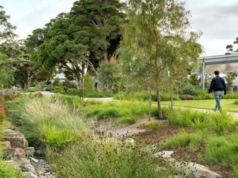A collaboration between IPWEA and two South Australian organisations will result in an eBook guide and online training course on the best practice use of recycled material in infrastructure assets that could have a global application.
IPWEA is working with the Waste and Recycling Industry South Australia (WRISA) and the Local Government Association LGA off SA with funding from the Green Industries SA Circular Economy Market Development Grant.
IPWEA’s Director of Sustainability, Dr. Jacqueline Balston, said the project would leverage South Australia’s world leading recycling practices and distil these into a manual and training course for best practice that would be of relevance to asset management organisations and practitioners worldwide.
“South Australia has been a leader in recycling, since the days of encouraging bottle recycling via the container deposit scheme,” said Balston.
“It’s a good place to begin to understand recycling and how we might increase the use of recycled materials in infrastructure, and many South Australian councils are actively embracing practices for the circular economy.”
Infrastructure accounts for approximately 70% of global greenhouse gas emissions, according to the World Bank, and half of all resources used and waste created globally.
Local Government and asset management staff are in the first line of planning and construction for much of Australia’s infrastructure, so are well placed to implement recycling practices.
The recently released Australia’s Local Government 2021 National State of the Assets Report identified that Australian local government currently has control of a $523 billion dollar asset portfolio that is growing at a steady state of 6.4% and being consumed at a rate of 1.6% per annum. It is projected that 60%-70% of the 2050 infrastructure is not yet built.
The ‘Boosting Recycled Material Use In Infrastructure Assets’ project will build collaborative links, extend knowledge, address barriers and give practitioners confidence to extend their use of recycled materials into infrastructure assets.
Asphalt, concrete, steel, glass, tyres, plastics, PVC and organics will all be included and their potential use in over 200 assets including roads, bridges, buildings, footpaths, curbing, water treatment, water supply and stormwater assets, fencing and outdoor furniture will be assessed.
This project will boost the use of recycled material in infrastructure assets by producing an industry led, innovative, best practice guideline – or Practice Note – and Online Training Course for asset managers, engineers, local government and consultants.
It will achieve this by addressing the gaps in technical knowledge, procurement options and practical training by producing resources that summarise in practical language the very latest in recycled materials research and link it to potential uses in infrastructure assets.
The incorporation of recycled material into infrastructure assets has the potential to increase asset life, market demand for recycled materials, innovation, new market opportunities, and reduce impacts to the environment.
One Australian example from Victoria was the use of soft plastics from approximately 200,000 plastic bags and packaging, 63,000 glass bottle equivalents, toner from 4,500 used printer cartridges and 50 tonnes of recycled asphalt build a build a road in Craigieburn, located in Melbourne’s north. The project was a partnership between engineering company Downer, Hume City Council, Close the Loop, Sustainability Victoria and the RED Group.
Tasmania is also expanding the use of recycled materials in new roads, following on from the use of recycled truck tyres used on the Bass, East Tamar and West Tamar highways.
Downer Group has announced it will build a new $10 million asphalt manufacturing facility in northern Tasmania producing Reconophalt, a road surfacing product that incorporates otherwise landfill-bound materials such as soft plastics, ground glass, road millings, reclaimed asphalt, and ink toner.
The IPWEA Practice Note project follows the 2020 development of the earlier IPWEA Practice Note 12.1, “Climate change impacts on the useful life of infrastructure” which was launched as a manual for asset managers wanting to include the risks from climate change into sustainable and resilient climate change planning.














